2003 MERCEDES-BENZ E320 WAGON engine coolant
[x] Cancel search: engine coolantPage 324 of 354
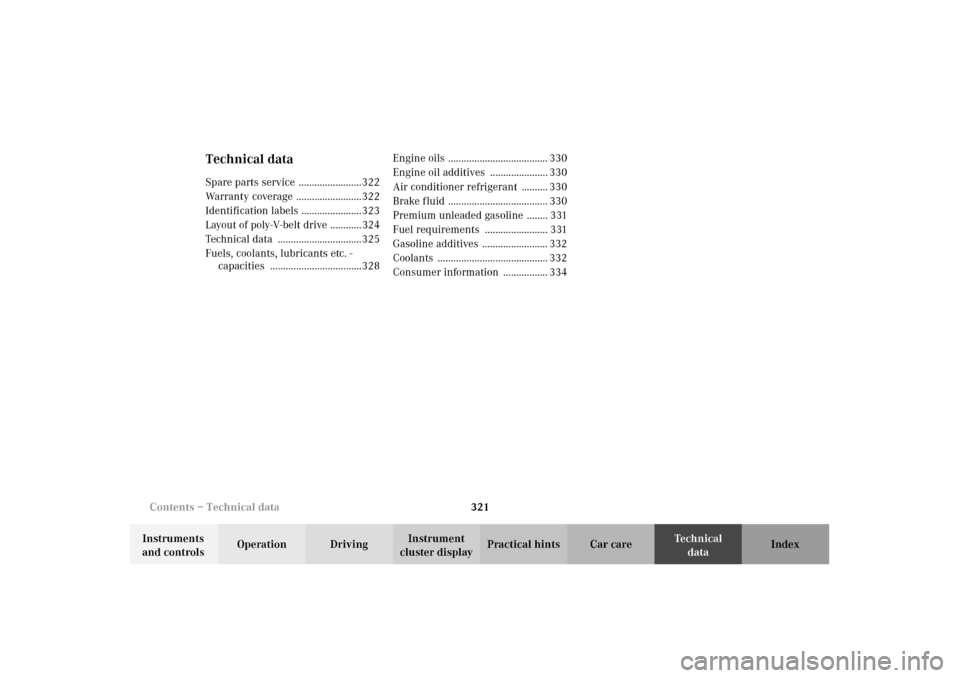
321 Contents – Technical data
Te ch n i c a l
data Instruments
and controlsOperation DrivingInstrument
cluster displayPractical hints Car care Index
Technical dataSpare parts service ........................322
Warranty coverage .........................322
Identification labels .......................323
Layout of poly-V-belt drive ............324
Technical data ................................325
Fuels, coolants, lubricants etc. -
capacities ...................................328Engine oils ...................................... 330
Engine oil additives ...................... 330
Air conditioner refrigerant .......... 330
Brake fluid ...................................... 330
Premium unleaded gasoline ........ 331
Fuel requirements ........................ 331
Gasoline additives ......................... 332
Coolants .......................................... 332
Consumer information ................. 334
Page 327 of 354
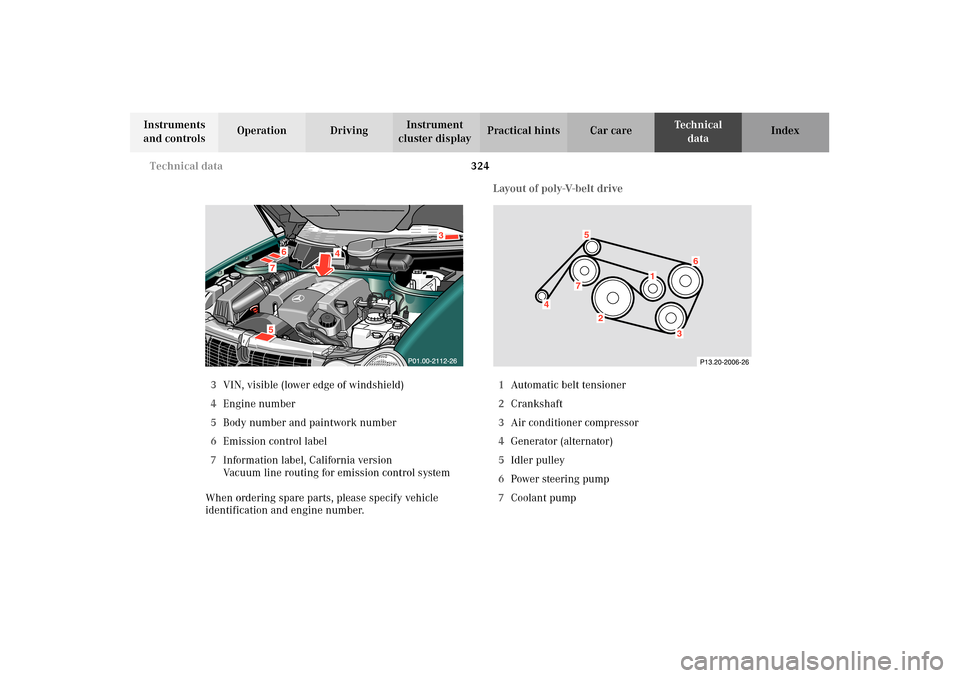
324 Technical data
Te ch n i c a l
data Instruments
and controlsOperation DrivingInstrument
cluster displayPractical hints Car care Index
3VIN, visible (lower edge of windshield)
4Engine number
5Body number and paintwork number
6Emission control label
7Information label, California version
Vacuum line routing for emission control system
When ordering spare parts, please specify vehicle
identification and engine number.Layout of poly-V-belt drive
1Automatic belt tensioner
2Crankshaft
3Air conditioner compressor
4Generator (alternator)
5Idler pulley
6Power steering pump
7Coolant pump
6
7
4
3
5
6
5
1
2
3
7
4
Page 331 of 354
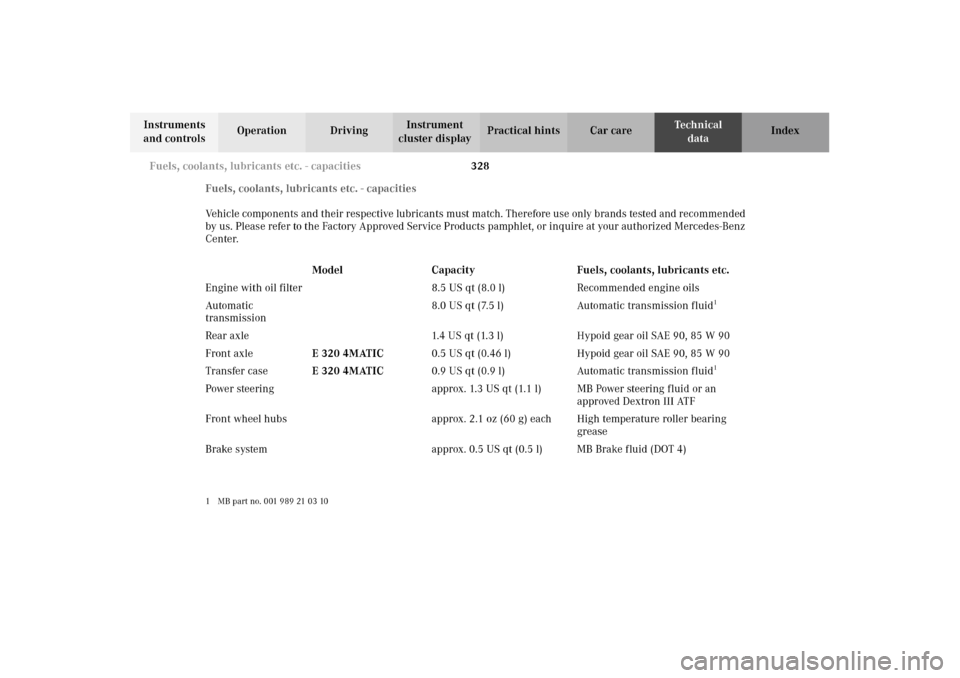
328 Fuels, coolants, lubricants etc. - capacities
Te ch n i c a l
data Instruments
and controlsOperation DrivingInstrument
cluster displayPractical hints Car care Index
Fuels, coolants, lubricants etc. - capacities
Vehicle components and their respective lubricants must match. Therefore use only brands tested and recommended
by us. Please refer to the Factory Approved Service Products pamphlet, or inquire at your authorized Mercedes-Benz
Center.
Model Capacity Fuels, coolants, lubricants etc.
Engine with oil filter 8.5 US qt (8.0 l) Recommended engine oils
Automatic
transmission8.0 US qt (7.5 l) Automatic transmission fluid
1
Rear axle 1.4 US qt (1.3 l) Hypoid gear oil SAE 90, 85 W 90
Front axleE 320 4MATIC0.5 US qt (0.46 l) Hypoid gear oil SAE 90, 85 W 90
Transfer caseE 320 4MATIC0.9 US qt (0.9 l) Automatic transmission fluid
1
Power steering approx. 1.3 US qt (1.1 l) MB Power steering fluid or an
approved Dextron III ATF
Front wheel hubs approx. 2.1 oz (60 g) each High temperature roller bearing
grease
Brake system approx. 0.5 US qt (0.5 l) MB Brake fluid (DOT 4) 1 MB part no. 001 989 21 03 10
Page 333 of 354

330 Fuels, coolants, lubricants etc. - capacities
Te ch n i c a l
data Instruments
and controlsOperation DrivingInstrument
cluster displayPractical hints Car care Index
Engine oils
Engine oils are specifically tested for their suitability in
our engines. Therefore, use only engine oils
recommended by Mercedes-Benz. Information on
recommended brands is available in the Factory
Approved Service Products pamphlet , or at your
authorized Mercedes-Benz Center.
Please follow Service Booklet recommendations for
scheduled oil changes. Failure to do so could result in
engine damage not covered by the Mercedes-Benz
Limited Warranty.
Engine oil additives
Do not blend oil additives with engine oil. They may be
harmful to the engine operation.
Damage or malfunctions resulting from blending oil
additives are not covered by the Mercedes-Benz Limited
Warranty.Air conditioner refrigerant
R-134a (HFC) refrigerant and special PAG lubricating oil
is used in the air conditioner system.
Never use R-12 (CFC) or mineral-based lubricating oil,
otherwise damage to the system will occur.
Brake fluid
During vehicle operation, the boiling point of the brake
fluid is continuously reduced through the absorption of
moisture from the atmosphere. Under extremely hard
operating conditions, this moisture content can lead to
the formation of bubbles in the system thus reducing
the system’s efficiency.
The brake fluid must therefore be replaced every two
years, preferably in the spring.
It is recommended to use only brake fluid approved by
Mercedes-Benz. Your authorized Mercedes-Benz Center
will provide you with additional information.
Page 334 of 354
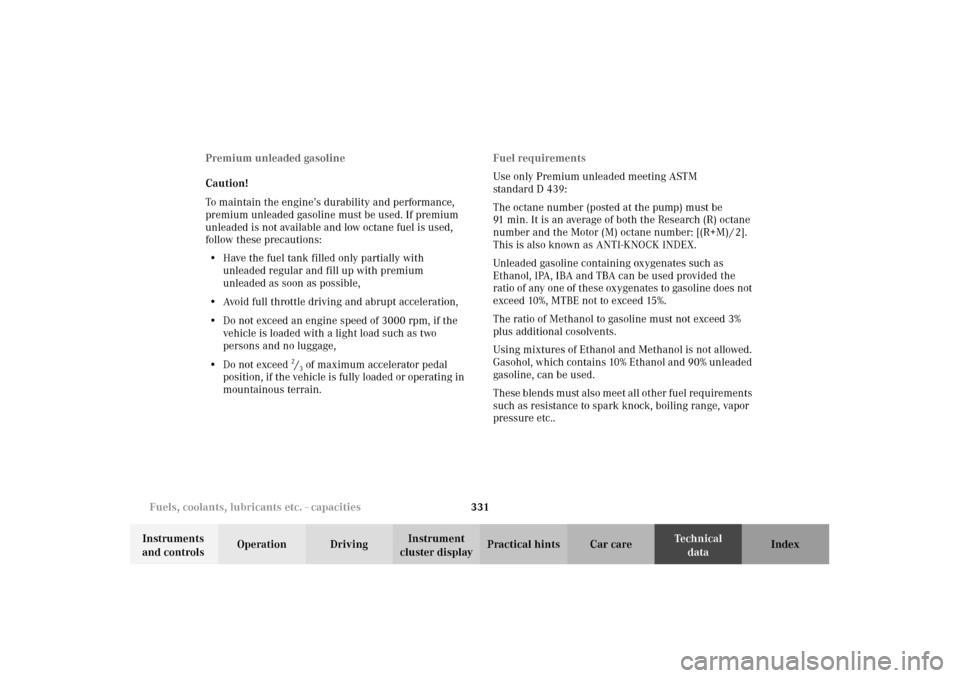
331 Fuels, coolants, lubricants etc. - capacities
Te ch n i c a l
data Instruments
and controlsOperation DrivingInstrument
cluster displayPractical hints Car care Index Premium unleaded gasoline
Caution!
To maintain the engine’s durability and performance,
premium unleaded gasoline must be used. If premium
unleaded is not available and low octane fuel is used,
follow these precautions:
•Have the fuel tank filled only partially with
unleaded regular and fill up with premium
unleaded as soon as possible,
•Avoid full throttle driving and abrupt acceleration,
•Do not exceed an engine speed of 3000 rpm, if the
vehicle is loaded with a light load such as two
persons and no luggage,
•Do not exceed
2/3 of maximum accelerator pedal
position, if the vehicle is fully loaded or operating in
mountainous terrain.Fuel requirements
Use only Premium unleaded meeting ASTM
standard D 439:
The octane number (posted at the pump) must be
91 min. It is an average of both the Research (R) octane
number and the Motor (M) octane number: [(R+M) / 2].
This is also known as ANTI-KNOCK INDEX.
Unleaded gasoline containing oxygenates such as
Ethanol, IPA, IBA and TBA can be used provided the
ratio of any one of these oxygenates to gasoline does not
exceed 10%, MTBE not to exceed 15%.
The ratio of Methanol to gasoline must not exceed 3%
plus additional cosolvents.
Using mixtures of Ethanol and Methanol is not allowed.
Gasohol, which contains 10% Ethanol and 90% unleaded
gasoline, can be used.
These blends must also meet all other fuel requirements
such as resistance to spark knock, boiling range, vapor
pressure etc..
Page 335 of 354
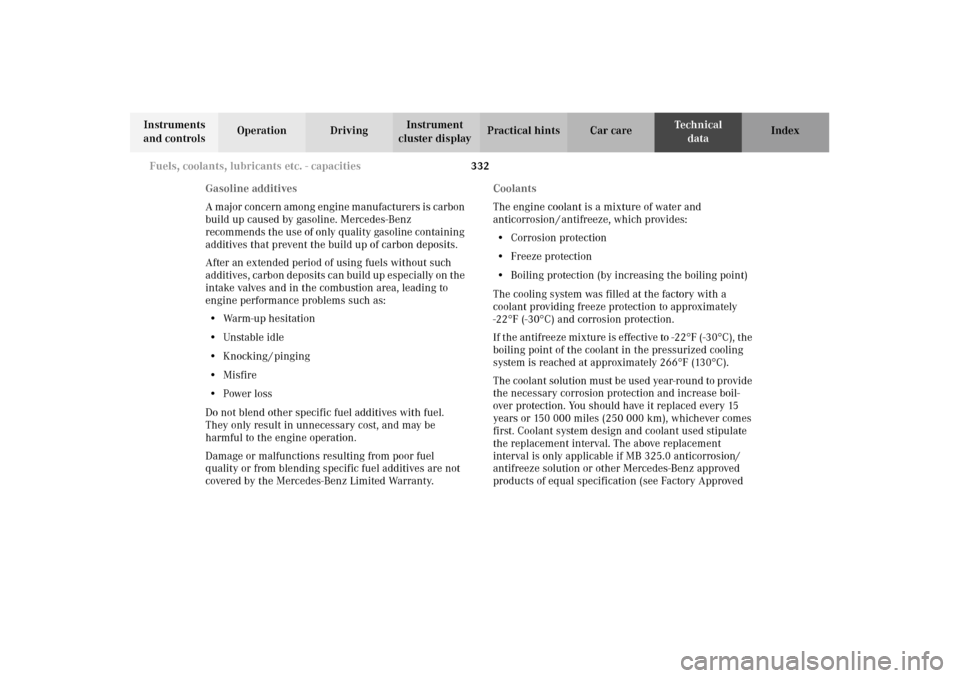
332 Fuels, coolants, lubricants etc. - capacities
Te ch n i c a l
data Instruments
and controlsOperation DrivingInstrument
cluster displayPractical hints Car care Index
Gasoline additives
A major concern among engine manufacturers is carbon
build up caused by gasoline. Mercedes-Benz
recommends the use of only quality gasoline containing
additives that prevent the build up of carbon deposits.
After an extended period of using fuels without such
additives, carbon deposits can build up especially on the
intake valves and in the combustion area, leading to
engine performance problems such as:
•Warm-up hesitation
•Unstable idle
•Knocking / pinging
•Misfire
•Power loss
Do not blend other specific fuel additives with fuel.
They only result in unnecessary cost, and may be
harmful to the engine operation.
Damage or malfunctions resulting from poor fuel
quality or from blending specific fuel additives are not
covered by the Mercedes-Benz Limited Warranty.Coolants
The engine coolant is a mixture of water and
anticorrosion / antifreeze, which provides:
•Corrosion protection
•Freeze protection
•Boiling protection (by increasing the boiling point)
The cooling system was filled at the factory with a
coolant providing freeze protection to approximately
-22
°F (-30
°C) and corrosion protection.
If the antifreeze mixture is effective to -22
°F (-30
°C), the
boiling point of the coolant in the pressurized cooling
system is reached at approximately 266
°F (130
°C).
The coolant solution must be used year-round to provide
the necessary corrosion protection and increase boil-
over protection. You should have it replaced every 15
years or 150 000 miles (250 000 km), whichever comes
first. Coolant system design and coolant used stipulate
the replacement interval. The above replacement
interval is only applicable if MB 325.0 anticorrosion/
antifreeze solution or other Mercedes-Benz approved
products of equal specification (see Factory Approved
Page 336 of 354

333 Fuels, coolants, lubricants etc. - capacities
Te ch n i c a l
data Instruments
and controlsOperation DrivingInstrument
cluster displayPractical hints Car care Index Service Products pamphlet) are used to renew the
coolant concentration or bring it back up to the proper
level.
To provide the important corrosion protection, the
solution must be at least 45% anticorrosion / antifreeze
(equals a freeze protection to approx. - 22
°F [- 30
°C]). If
you use a solution that is more than 55% anticorrosion /
antifreeze (freeze protection to approx. - 49
°F [- 45
°C]),
the engine temperature will increase due to the lower
heat transfer capability of the solution. Therefore, do not
use more than this amount of anticorrosion / antifreeze.
If the coolant level is low, water and MB anticorrosion /
antifreeze should be used to bring it up to the proper
level (have cooling system checked for signs of leakage).
Please make sure that the mixture is in accordance with
label instructions.
The water in the cooling system must meet minimum
requirements, which are usually satisfied by normal
drinking water. If your are not sure about the water
quality, consult your authorized Mercedes-Benz Center.
Anticorrosion / antifreeze
Your vehicle contains a number of aluminum parts. The
use of aluminum components in motor vehicle engines
necessitates that anticorrosion / antifreeze coolant used in such engines be specifically formulated to protect the
aluminum parts. (Failure to use such anticorrosion /
antifreeze coolant will result in a significantly
shortened service life.)
Therefore the following product is strongly
recommended for use in your car: Mercedes-Benz 325.0
Anticorrosion / Antifreeze Agent.
Before the start of the winter season (or once a year in
the hot southern regions), you should have the
anticorrosion / antifreeze concentration checked. The
coolant is also regularly checked each time you bring
your vehicle to your authorized Mercedes-Benz Center
for service.
Anticorrosion / antifreeze quantity
Approx. freeze protection
– 35
°F
(– 37 °C)– 49
°F
(– 45 °C)
5.6 US qt
(5.3 l)5.8 US qt
(5.5 l)
Page 340 of 354
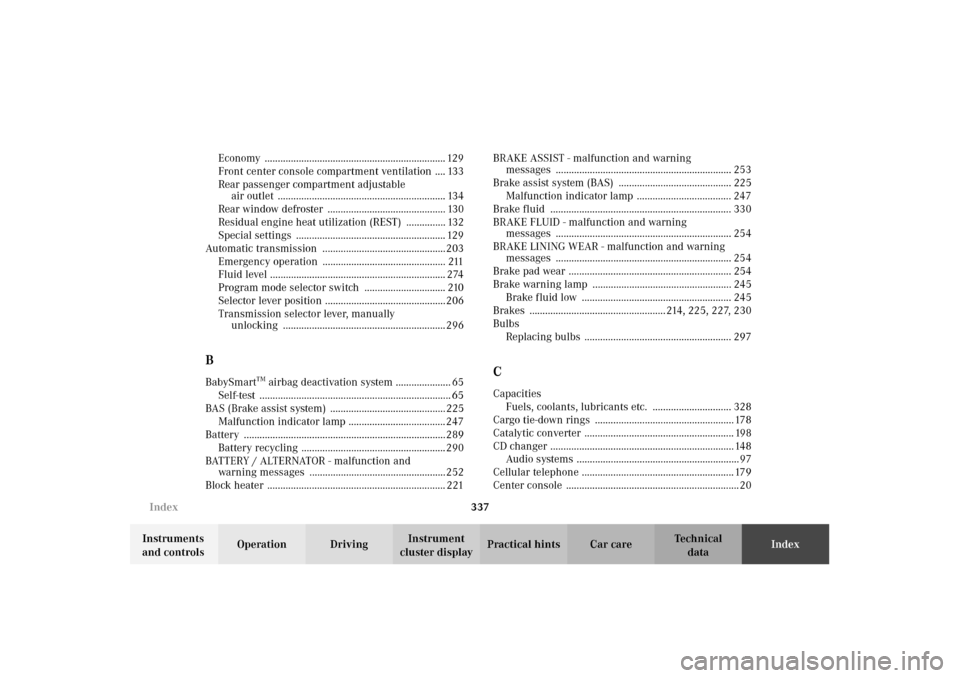
337 Index
Te ch n i c a l
data Instruments
and controlsOperation DrivingInstrument
cluster displayPractical hints Car careIndex Economy ..................................................................... 129
Front center console compartment ventilation .... 133
Rear passenger compartment adjustable
air outlet ................................................................ 134
Rear window defroster ............................................. 130
Residual engine heat utilization (REST) ............... 132
Special settings ......................................................... 129
Automatic transmission ...............................................203
Emergency operation ............................................... 211
Fluid level ................................................................... 274
Program mode selector switch ............................... 210
Selector lever position ..............................................206
Transmission selector lever, manually
unlocking .............................................................. 296
BBabySmart
TM airbag deactivation system ..................... 65
Self-test ......................................................................... 65
BAS (Brake assist system) ............................................ 225
Malfunction indicator lamp ..................................... 247
Battery .............................................................................289
Battery recycling ....................................................... 290
BATTERY / ALTERNATOR - malfunction and
warning messages ....................................................252
Block heater .................................................................... 221BRAKE ASSIST - malfunction and warning
messages ................................................................... 253
Brake assist system (BAS) ........................................... 225
Malfunction indicator lamp .................................... 247
Brake fluid ..................................................................... 330
BRAKE FLUID - malfunction and warning
messages ................................................................... 254
BRAKE LINING WEAR - malfunction and warning
messages ................................................................... 254
Brake pad wear .............................................................. 254
Brake warning lamp ..................................................... 245
Brake fluid low ......................................................... 245
Brakes .................................................... 214, 225, 227, 230
Bulbs
Replacing bulbs ........................................................ 297
CCapacities
Fuels, coolants, lubricants etc. .............................. 328
Cargo tie-down rings ..................................................... 178
Catalytic converter ......................................................... 198
CD changer ...................................................................... 148
Audio systems ..............................................................97
Cellular telephone .......................................................... 179
Center console .................................................................. 20